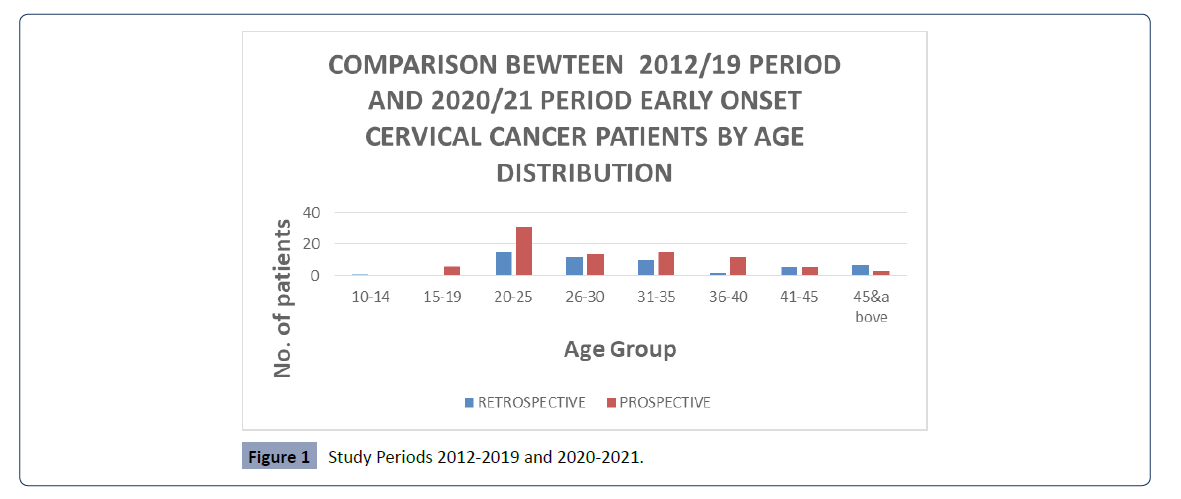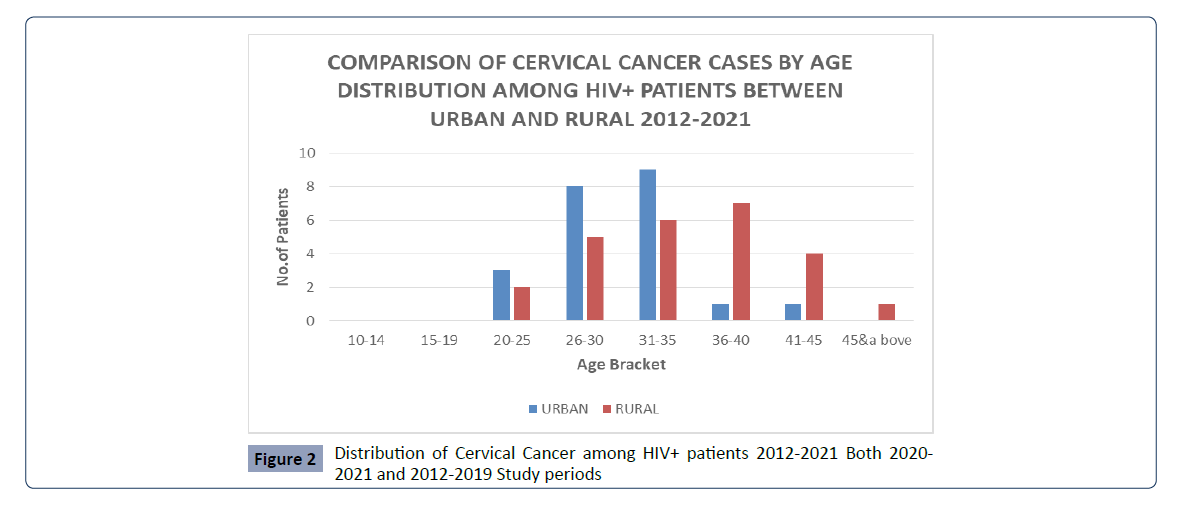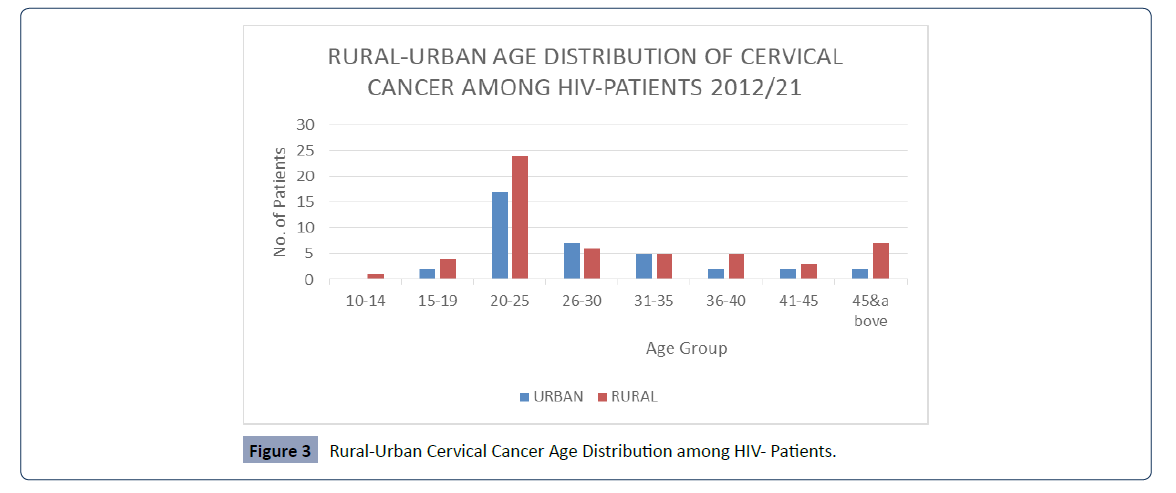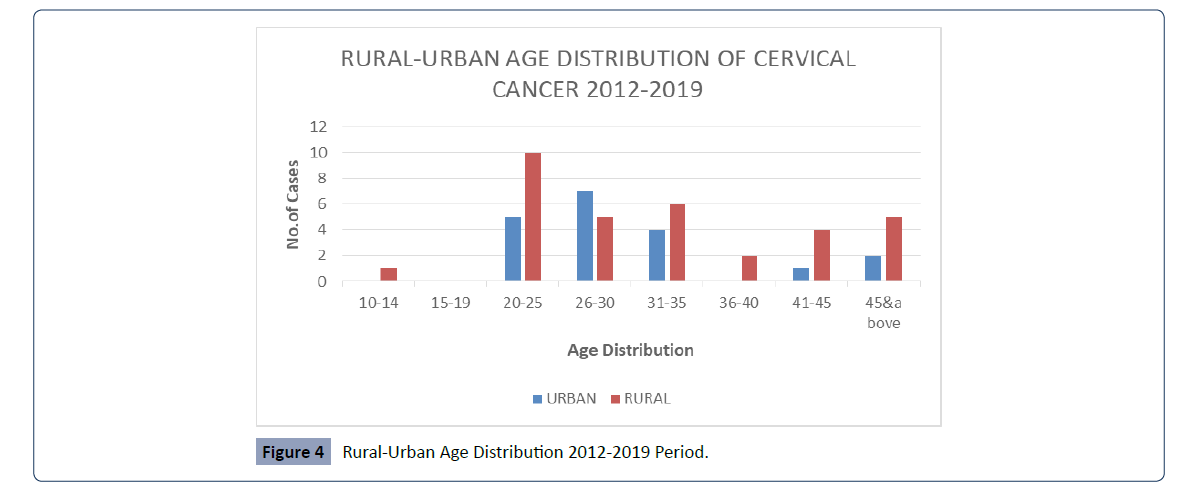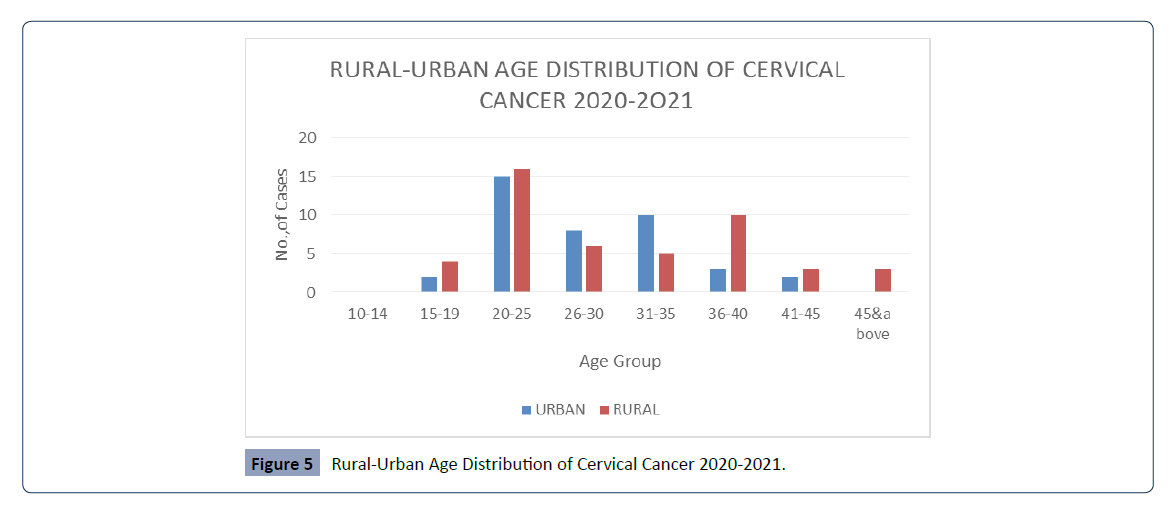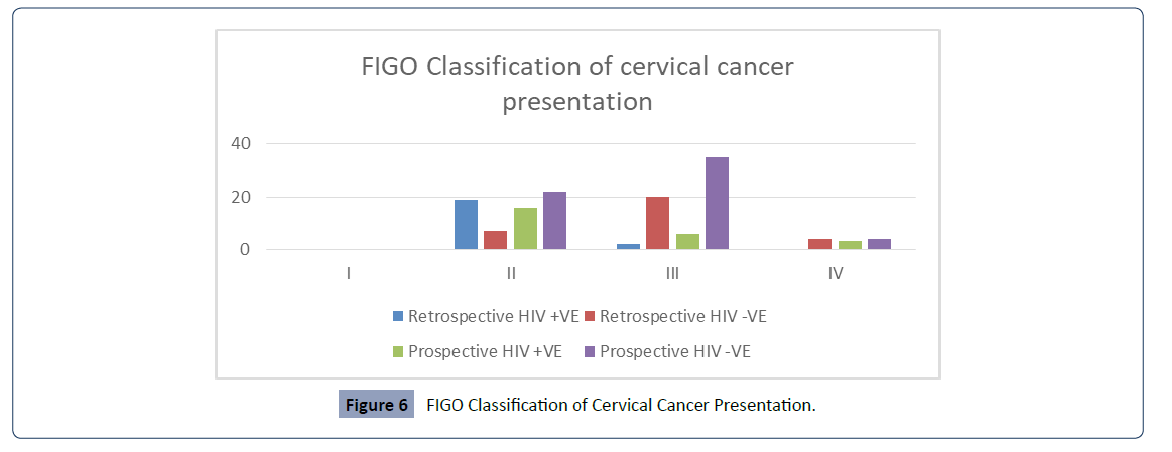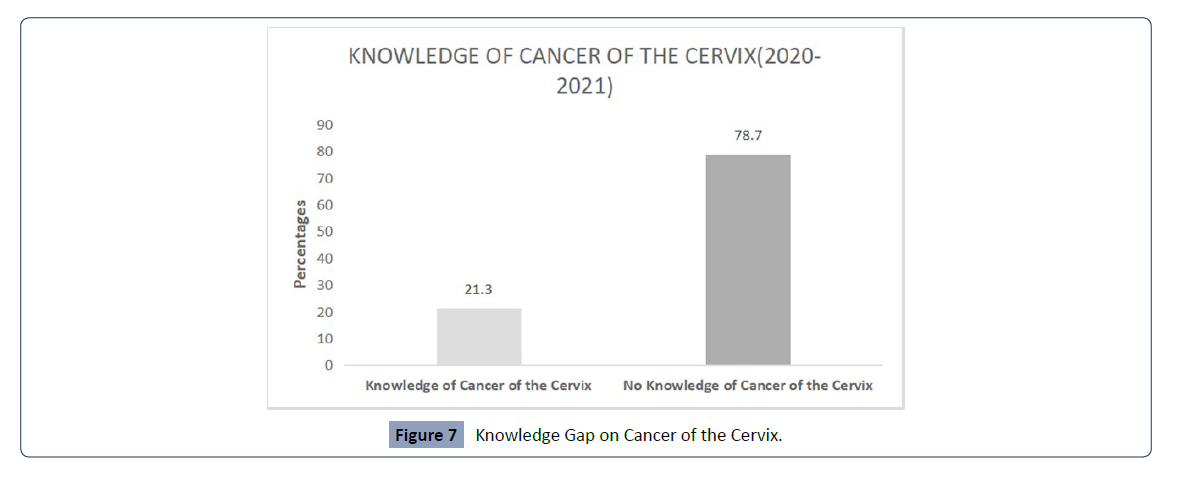Abstract
Background: in many Low and middle income countries HIV and cervical cancer have always been interlinked, as HIV patients are more likely to be diagnosed with cervical cancer at a young age. The policy in Kenya is to screen all HIV positive women for cancer of the cervix.
Objective: This study aimed to explore the increase in incidences of advanced cervical cancer in young HIV Negative women, as compared to HIV Positive, presenting at the hospital. Methodology: A review of hospital records of all patients aged 13-35 years presenting with Cancer of the Cervix regardless of HIV status at time of diagnosis in the period 2012 - 2019 of the study and purposive active recruitment of same age set in the 2020 – 2021period.
Findings: After the introduction of routine screening of HIV +VE women, there was an increase of 18% of routine early screening of cancer of the cervix in the young HIV +VE patients as compared to their HIV–VE counterparts, from 10% to 28% in the 2012- 2019 and 2020-2021 study periods.
Conclusion: Our conclusion is that apparently due to the early routine cancer of the cervix screening of young HIV positive women, cases are being diagnosed very early, in the pre-cancer and early stages, leading to early treatment and remission, in turn leading to the increased contribution of young HIV negative women with advanced cancer of the cervix
Keywords
Policy; Routine; Young-women; HIV; Hospital Records and Western Kenya
Introduction
Cervical cancer is the fourth most common cancer among women
globally, with an estimated 604,000 new cases and 342,000 deaths
in 2020 [1]. About 90% of the new cases and deaths worldwide in
2020 occurred in low and middle-income countries [1].
Sub-Saharan Africa (SSA) has the highest burden of cervical cancer
in the world. Africa accounted for 21% of total cases and 26% of
global deaths from cervical cancer in 2012 [1, 2]. In Africa, Cervical
cancer is the leading cause of cancer-related deaths in women in
Eastern, Western, Middle, and Southern Africa and these women
in Sub-Saharan Africa are disproportionately affected with cancer
of the cervix, between 2% to 4% having a lifetime risk of the disease [1] In 2018, cervical cancer was the fourth most common
cancer among women and the seventh most common cancer
overall with 570,000 new cases and 311, 000 deaths reported
[2] 85% of whom were in low-middle-income countries, where
vaccination, screening and treatment programs are limited [3]
Eighty percent (80%) of the new cases occur in low and middle
income countries, where it is the most common cancer in
women, accounting for 13 % of all cancers in female patients [1,4] Western countries have experienced dramatic reductions in
the incidence of and mortality from invasive cervical cancer, due
to interventions that include vaccination against HPV and early
diagnosis and treatment of patients with cervical cancer [5 ].
In Kenya, Cervical cancer contributes approximately 12% of all
cancer cases diagnosed, and is the leading cause of all cancer
deaths, with over 3,200 deaths reported in 2020 [1]. The uptake
of screening is low (approximately 16% in 2015) [6] and only a
quarter of 2,927 sampled health facilities offered screening in
2018, [6] despite the fact that Kenya has been implementing a
national screening programme for more than a decade [7].
The HIV/AIDS epidemic led to Early Onset incidences of cervical
cancer at a global level, with increasing incidence in women below
40 years of age, compared to the previous age - set of women in
their 6th-7th decades of life developing cervical cancer, before
the onset of HIV/AIDS [8, 9 ]. In HIV-infected women, there is
an increased risk of HPV infection and squamous intraepithelial
lesions {SIL}, the precursor of cervical cancer [10, 11 ].
Early onset cancers, defined as cancers in adults aged 18 to
49 years, are increasing in incidence, in a number of cancer
sites in developed countries [12]. The incidence rate of earlyonset
cancers increased by 20.5% from1993-2019 in Northern
Ireland [12]. The impact of cancer treatment on fertility and
fertility preservation treatments is an important consideration,
bearing in mind that patients with early-onset cancers face
unique supportive care needs and require holistic care [12]. An
increased use of screening programmes has contributed to this
phenomenon of early-onset cervical cancer to a certain extent
(although the uptake in Kenya is still very low), a genuine increase
in the incidence have emerged. Evidence suggests an aetiological
role of risk factor exposures in early life and young adulthood
[13]. Since the mid-20th century, substantial multigenerational
changes in the exosomes have occurred, including changes in diet,
lifestyle, obesity, environment and the micro biome,, all of which
might interact with genomic and/or genetic susceptibilities [13].
This may reflect age-cohort effects and the emergence of more
aggressive histologies with a shorter natural history, possibly
the result of Human Papilloma Virus {HPV} infection acquired at
a younger age or of increased screening/awareness resulting in
earlier detection of cervical cancer [8, 9].
Climate change is also affecting health and health patterns, which
need to be studied, to evacuate and mitigate any impacts it may
be having in early development of cancers globally.
We observed recently, that the number of Early Onset cancer of
the cervix in HIV negative women of ages 13-35 years, diagnosed
with advanced cancer of the cervix, has been increasing steadily
at JOOTRH as from 2020 as compared to the previous period since
inception of the Oncology Clinic in January 2012 to December
2019. This is opposed to the recent documented development
of cervical cancer in HIV-negative women, which has been from
the 4th to the 7th decade’s overtime, most frequently diagnosed
in the U.S between the ages of 35 -44, with the average age at
diagnosis being 50 years old, more than 20% are diagnosed at 65
years of age, according to the American Cancer Society, updated
2023 [7].
The Early Onset cancer of the cervix has led to the young women
having aggressive managements including hysterectomies
depending on the stage of the disease. This has led to
increased psychological complications which are attached to
the consequences of the surgeries in women who had plans of
having sizable families in the future. This has introduced a new
dimension in the hospital management of these young women,
some of whom are nulliparous.
In respect to the above, this study’s objective was to investigate
the increase in incidences of Early Onset cancer of the cervix in
HIV-VE women coming to the oncology clinic at the Jaramogi
Oginga Odinga Teaching and Referral Hospital.
Materials and Methods
Study site
The study was conducted at the Oncology Clinic of the Jaramogi
Oginga Odinga Teaching and Referral Hospital {JOOTRH}. Kisumu
County, about 6 Kilometres from the Kisumu city business district
(CBD), along the Kisumu-Kakamega road next to the Western
region’s Blood Transfusion Centre. The Oncology Clinic is a
separated from the administration block by a small fishpond and
is next to the JOOTRH College’s Director’s office.
The Clinic operates 8 hours per day from Monday to Friday and
has a staff base made of 1 Gynaecology-Oncologist 1 Medical-
Oncologist 1 Medical officer, 4 Nurses, 1 Nutritionist, 1 Pharmacist
and 1 support staff.
Kisumu City of Kisumu County is the third-largest city in Kenya
after the capital, Nairobi, and Mombasa [14]. It is the secondlargest
city after Kampala in the Lake Victoria Basin. Located at
the shores of the world’s second largest freshwater lake, Lake
Victoria and at 1,131 m (3,711 ft.), the vibrant third largest city in
Kenya, Kisumu City, boasts of a rich history of international trade,
tropical climate, good transport network and a vibrant population
majorly the Luo ethnic tribe of Kenya. The city has a population of
slightly over 600, 000 [14]. The metro region, including Maseno
and Ahero has a population of 1,155,574 people (560,942 males,
594,609 females) according to the 2019 Kenya Population and
Housing census which was conducted by the Kenya national
Bureau of Statistics [14]. Kisumu is the principal city of western
Kenya and forms the commercial, industrial and transportation
center majorly due to its water and rail connections. Formally
the headquarters of the greater Nyanza Province, the town has
grown to be the third largest city in Kenya after Nairobi and
Mombasa and is now the headquarters of Kisumu County. The
main industries in Kisumu are cantered around processing of
agricultural products, fishing, brewing and textile manufacturing
industries. The Luo tribe is the main inhabitants of Kisumu County,
but because it is made up of the city and rural areas around the
metro zone, it is a melting pot of other tribes like the Luhya, Kisii,
Kuria, Somali, Kikuyu, Kamba and others [14].
The JOOTRH also serves the neighbouring counties of Kakamega,
Siaya, Kisii, Nyamira, HomaBay, Busia, Bungoma and Migori [14].
JOOTRH is a teaching and referral hospital, where many cancer
cases such as gynaecological cancers are treated. It serves as the
only oncology referral hospital in the county and for the counties of Siaya, HomaBay, Migori, Nyamira and Busia. Management
of cervical cancer offered at this facility includes surgery and
chemotherapy but has no radiotherapy unit. It offers also CT and
MRI imaging and a well-equipped Pathology laboratory. The HIVClinic
screens newly diagnosed patients for cancer of the cervix
after two months of attendance treat pre-cancerous lesions
immediately and refer the confirmed cancers to the Oncology
Clinic.
Inclusion/Exclusion Criteria
The study included all the files of patients with early onset cervical
cancer of ages 13-35 years, who were both HIV- Negative and HIV
- Positive at time of diagnosis and had histological diagnosis, in
the period 2012-2019. We also purposively recruited all patients
with above characteristics in the period of 2020-2021.
Sample
In this quantitative and qualitative study, in the 2012-2019
periods, patients’ files for all HIV positive and negative cervical
cancer patients who were of the ages 13-35 years old were
purposively selected. The samples consisted of HIV +VE and HIVVE
patients with Early Onset cervical cancer, and were being
treated at the oncology clinic of the JOOTRH, since the inception
of the clinic in January 2012-2019 December. In the period
of 2020-2021, participants were purposively selected using
maximum variation sampling strategy, as they were diagnosed
and registered in the Oncology clinic. The patients were drawn
from different population categories of ethnicities, socioeconomic
statuses, place of residences, level of education and
religion. A total sample size of 52 files was selected, in the period
of 2012 – 2019 and a sample of 86 participants was recruited
actively in the prospective period of 2020 – 2021.
Procedure and Research design
This was a mixed-methods study design, including both
quantitative and qualitative components. The quantitative
components focused on age sets, HIV statuses, cervical cancer
vaccination, screening, diagnosis, histology results, Figo Staging
in the period of 2012-2019 and 2020-2021 data reviews and
analysis, with data sources being the patient files in the former
period while using clinical research forms and other source
documents in the latter period. The qualitative component
involved evaluating knowledge about cervical cancer, sourced
through review of files and use of clinical research forms and
semi-structured interviews in the former and latter periods
respectively. The study was based on the JOOTRH’s Oncology
Clinic services to patients with early onset cervical cancer in both
periods, within the age set of 13-35 years old.
Study period
The review of files was done for the period of 8 years since the
inception of the Oncology in January 2012 to December 2019
(2012-2019), and the period of active recruitment, collection of
data with clinical research forms and other source documents
was in the period of September 2020 to September 2021 (2020-
2021). Measurement
Data was collected using structured document analysis forms and lists in the period of 2012-2019, while clinical research forms and
semi-structured interviews were used for data collection in the
period of 2020-2021. The study specifically sought to determine
the incidences of early onset cervical cancer cases, HIV-status,
the patients’ demographics, knowledge of cancer, vaccinated
against HPV, screening, stage of disease and histological results
of the cancer tissues.
The primary outcome variable was the incidences of Early Onset
Cancer of the cervix in both HIV Positive and Negative women
of ages 13-35 years old. This variable was measured through all
the reviewed files in the period 2012 - 2019 and of the actively
recruited patients in the period 2020 - 2021.
The quantitative data were analyzed using Epi Info TM 7.0
(US CDC, Atlanta, GA). The qualitative data was thematically
tabulated while the quantitative data was summarized in trend
series (bar charts and line graphs).
Ethical Considerations
All the documents analyzed and patients recruited in this study,
were accessed after getting an approval from the JOOTRH’s
Ethical Review Committee (I.E.R.C) and express informed consent
from the recruited patients. There was no patient who was
coerced into joining the study and those who declined were not
denied the standard of care for their ailment.
The approval for the review of the hospital records for the
period 2012-2019 and active recruitment of patients for the
2020-2021 period, included statements about the rights of the
subjects, in terms of their information collected, confidentiality
and the publication of this report and any other accompanying
information (Tables 1-5).
| Characteristics |
n = 16 |
|
| n / median |
% / range |
| Age, years |
27 |
13-35 |
| Residence |
|
|
| Urban |
6 |
37.50% |
| Rural |
10 |
62.50% |
| Vaccinated against H.P.V |
|
|
| Yes |
0 |
0% |
| No |
16 |
100% |
| Screened Voluntarily Prior to Symptoms |
|
|
| Yes |
2 |
12.50% |
| No |
4 |
25% |
| HIV Status |
|
|
| Negative |
0 |
0% |
| Positive |
16 |
100% |
| On HAART |
|
|
| Yes |
16 |
100% |
| No |
0 |
0% |
| FIGO 2012/2019 stage |
|
|
| IIA2 |
12 |
75% |
| IIB |
4 |
25% |
| Tumour size, mm |
48mm |
>40mm |
| Histology |
|
|
| Squamous cell carcinoma |
13 |
81.25%% |
| Adenocarcinoma |
2 |
12.50% |
| Adeno - squamous cell carcinoma |
1 |
6.25% |
| Small Cell Neuro-Endocrine carcinoma |
0 |
0% |
| Type of imaging |
|
|
| CT |
16 |
100% |
| Patient-based nodal status on CT |
|
|
| Negative |
16 |
100% |
| Inconclusive |
0 |
0% |
| Positive |
0 |
0% |
| Region with positive nodal status on imaging b |
|
|
| Pelvic |
0 |
0% |
| Common iliac |
0 |
0% |
| Para-aortic |
0 |
0% |
| Patient-based nodal status on pathology |
|
|
| Negative |
16 |
100% |
| Positive |
0 |
0% |
| Unknown |
0 |
0% |
| Nodal examination |
|
|
| Absent |
16 |
100% |
| Lymphadenectomy |
0 |
0% |
| Nodal debunking |
0 |
0% |
| Biopsy/fine-needle aspiration |
16 |
100% |
| Sentinel node biopsy only |
0 |
0% |
Table 1. Cancer of Cervix Table in the Period 2012 -2019 for HIV +Ve Cohort
Characteristics |
n = 22 |
|
| n / median |
% / range |
| Age, years |
23 |
13-35 |
| Residence |
|
|
| Urban |
10 |
45.50% |
| Rural |
12 |
54.50% |
|
|
|
| Vaccinated against H.P.V |
|
|
| Yes |
0 |
0% |
| No |
22 |
100% |
| Screened Voluntarily Prior to Symptoms |
|
|
| Yes |
7 |
31.80% |
| No |
15 |
68.20% |
| HIV Status |
|
|
| Negative |
22 |
100% |
| Positive |
0 |
0% |
| On HAART |
|
|
| Yes |
0 |
0% |
| No |
22 |
100% |
| FIGO 2020/2021 stage |
|
|
| IIA2 |
2 |
9.10% |
| IIB |
5 |
22.70% |
| IIIB |
5 |
22.70% |
| IIIC1 |
4 |
18.20% |
| IIIC2 |
5 |
22.70% |
| IVB |
|
|
| Tumour size, mm |
62 |
> 40 |
| Histology |
|
|
| Squamous cell carcinoma |
16 |
72.70% |
| Adenocarcinoma |
2 |
9.10% |
| Adeno - squamous cell carcinoma |
4 |
18.20% |
| Small Cell Neuro-Endocrine carcinoma |
0 |
0% |
| Type of imaging |
|
|
| CT |
22 |
100% |
| Patient-based nodal status on CT |
|
|
| Negative |
10 |
45.50% |
| Inconclusive |
3 |
13.60% |
| Positive |
9 |
40.90% |
| Region with positive nodal status on imaging b |
|
|
| Pelvic |
9 |
40.90% |
| Common iliac |
2 |
9.10% |
| Para-aortic |
5 |
22.70% |
| Patient-based nodal status on pathology |
|
|
| Negative |
13 |
59% |
| Positive |
9 |
40.90% |
| Unknown |
0 |
0% |
| Nodal examination |
|
|
| Absent |
3 |
13.60% |
| Lymphadenectomy |
4 |
18.20% |
| Nodal debulking |
0 |
0% |
| Biopsy/fine-needle aspiration |
22 |
100% |
| Sentinel node biopsy only |
0 |
0% |
Table 2. Cancer of Cervix Table in the Period 2012 -2019 for Hiv–Ve Cohort
| Characteristics |
n=17 |
|
| n / median |
% / range |
| Age, years |
31 |
13-35 |
| Residence |
|
|
| Urban |
14 |
82.40% |
| Rural |
3 |
17.60% |
| Vaccinated against H.P.V |
|
|
| Yes |
0 |
0% |
| No |
17 |
100% |
| Screened Voluntarily Prior to Symptoms |
|
|
| Yes |
6 |
35.30% |
| No |
11 |
64.70% |
| HIV Status |
|
|
| Negative |
0 |
0% |
| Positive |
17 |
100% |
| On HAART |
|
|
| Yes |
17 |
100% |
| No |
0 |
0% |
| FIGO 2020/2021 stage |
|
|
| IIA2 |
9 |
52.90% |
| IIB |
3 |
17.60% |
| IIIB |
3 |
17.60% |
| IIIC1 |
1 |
5.90% |
| IIIC2 |
1 |
5.90% |
| IVB |
0 |
0% |
| Tumour size, mm |
75mm |
>40mm |
| Histology |
|
|
| Squamous cell carcinoma |
13 |
76.40% |
| Adenocarcinoma |
1 |
5.90% |
| Adeno-squamous cell carcinoma |
3 |
17.60% |
| Small Cell Neuro-Endocrine carcinoma |
0 |
0% |
| Type of imaging |
|
|
| CT |
17 |
100% |
| Patient-based nodal status on CT |
|
|
| Negative |
120 |
70.60% |
| Inconclusive |
30 |
17.60% |
| Positive |
2 |
11.80% |
| Region with positive nodal status on imaging b |
|
|
| Pelvic |
2 |
11.80% |
| Common iliac |
1 |
5.90% |
| Para-aortic |
1 |
5.90% |
| Patient-based nodal status on pathology |
|
|
| Negative |
15 |
88.20% |
| Positive |
2 |
11.80% |
| Unknown |
0 |
0% |
| Nodal examination |
|
|
| Absent |
5 |
29.40% |
| Lymphadenectomy |
2 |
11.80% |
| Nodal debunking |
0 |
0% |
| Biopsy/fine-needle aspiration |
17 |
100% |
| Sentinel node biopsy only |
0 |
0% |
Table 3. Cancer of Cervix Table in the Period 2020 -2021 for HIV +Ve Cohort
Characteristics |
n=49 |
|
| n / median |
% / range |
| Age, years |
23 |
13-35 |
| Residence |
|
|
| Urban |
21 |
42.90% |
| Rural |
28 |
57.10% |
| Vaccinated against H.P.V |
|
|
| Yes |
0 |
0% |
| No |
49 |
100% |
| Screened Voluntarily Prior to Symptoms |
|
|
| Yes |
10 |
20.40% |
| No |
39 |
79.60% |
| HIV Status |
|
|
| Negative |
49 |
100% |
| Positive |
0 |
0% |
| On HAART |
|
|
| Yes |
0 |
0% |
| No |
49 |
100% |
| FIGO 2020/2021 stage |
|
|
| IIA2 |
4 |
8.20% |
| IIB |
18 |
36.70% |
| IIIB |
10 |
20.40% |
| IIIC1 |
6 |
12.20% |
| IIIC2 |
9 |
18.40% |
| IVB |
|
|
| Tumour size, mm |
71 |
>40 |
| Histology |
|
|
| Squamous cell carcinoma |
30 |
61.20% |
| Adenocarcinoma |
5 |
10.20% |
| Adeno - squamous cell carcinoma |
10 |
20.40% |
| Small Cell Neuro-Endocrine carcinoma |
4 |
8.20% |
| Type of imaging |
|
|
| CT |
49 |
100% |
| Patient-based nodal status on CT |
|
|
| Negative |
30 |
61.20% |
| Inconclusive |
4 |
8.20% |
| Positive |
15 |
30.60% |
| Region with positive nodal status on imaging b |
|
|
| Pelvic |
15 |
30.60% |
| Common iliac |
4 |
8.20% |
| Para-aortic |
9 |
18.40% |
| Patient-based nodal status on pathology |
|
|
| Negative |
34 |
69.40% |
| Positive |
15 |
30.60% |
| Unknown |
0 |
0% |
| Nodal examination |
|
|
| Absent |
10 |
20.40% |
| Lymphadenectomy |
10 |
20.40% |
| Nodal debulking |
0 |
0% |
| Biopsy/fine-needle aspiration |
49 |
100% |
| Sentinel node biopsy only |
0 |
0% |
Table 4. Cancer of Cervix Table in the Period 2020 -2021 for Hiv–Ve Cohort.
| Age Group |
2012-2019 |
2020-2021 |
| Oct-14 |
1 |
0 |
| 15-19 |
0 |
6 |
| 20-25 |
15 |
31 |
| 26-30 |
12 |
14 |
| 31-35 |
10 |
15 |
| 36-40 |
2 |
12 |
| 41-45 |
5 |
5 |
| 45&above |
7 |
3 |
| TOTAL |
52 |
86 |
| P-VLUE |
0.012 |
0.017 |
| MEAN |
6.5 |
10.75 |
| CI (MEAN) |
1.921, 11.079 |
2.562, 18.938 |
| DF |
7 |
7 |
Table 5. Sample
Knowledge on Cancer of the Cervix
2020-2021 Period
Total Patients (HIV +VE and HIV –VE) = 86
Some Knowledge (13-35 years old) = 18
Hence Percentage = 18/86= 0.2093 x 100 = 20.93% = 21%
No Knowledge (13-35 years old) = 68
Hence Percentage = 68/86= 0.7906 x 100 = 79.06% = 79%
Interpretation
There is a significant knowledge gap on cancer of the cervix
amongst the young patients with early onset cancer of the cervix
(Table 6).
| |
Urban |
Rural |
Total |
| HIV+ |
22 |
25 |
47 |
| HIV- |
37 |
55 |
92 |
| Total |
59 |
80 |
139 |
Table 6. Analysis of predisposition of HIV+ women in rural to cervical cancer.
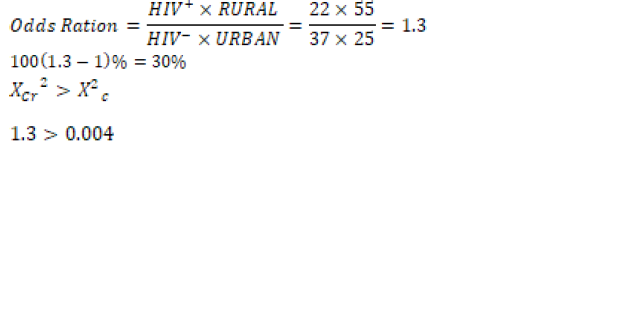
The results are statistically significant
Interpretation
• A HIV+ woman living in rural area is 30% more likely to get cervical cancer compared to HIV- in urban area
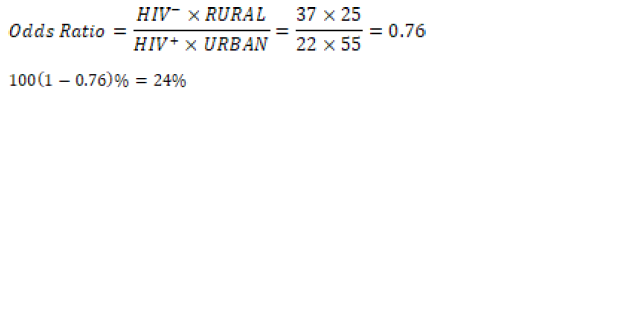
The result is statistically significant
Interpretation
• A HIV- woman living in rural area is 24% less likely to
get cervical cancer compared to HIV+ woman living in urban
area.
• HIV+ or HIV- woman in rural area has higher chances of
getting cervical cancer compared to their counterparts in urban
areas (Table 7).
|
URBAN |
RURAL |
Total |
| 2012-2019 |
19 |
33 |
52 |
| 2020-2021 |
40 |
47 |
87 |
| Total |
57 |
80 |
139 |
Table 7. The likelihood of getting cervical cancer in 2012-2019 and 2020-2021 periods
Odd Ratio= (2020-2021 Period Rural)/ (2012-2019
Period×Urban)=(19×47)/(40×33)=0.68'
100(1-0.68) %
[X_Cr] ^2>[X^2]c
0.68>0.004
The result is statistically significant
Interpretation
• A woman, whether in town or rural area was 32% less
likely to get cervical cancer between 2012 and 2019 compared to
2020-2021 period.
Discussions
The study showed increasing incidences of Early Onset cancer
of the cervix in HIV-VE young women at the JOOTRH. This in
agreement to the recent published data that has seen the
changing incidences of cervical cancer at a global level, with
increasing incidence in women below 40 years of age [15 , 16],
and a study that reported that eighty percent (80%) of the new
cases occur in developing countries, where it is the most common
cancer in women, accounting for 13% of all female cancers [17, 1]. This is also in agreement with the findings of a study that
stated that in 2020 estimates, cancer of the cervix incidences
increased in some countries in Eastern Africa and Eastern Europe
[18]. The Global incidence of early-onset cancer increased by
79.1% and the number or early-onset cancer deaths increased by
27.7% between 1990 and 2019 [19]. The results indicated that
in low-middle and low Socio-Demographic Index regions, earlyonset
cancers had a significantly higher impact on women than
on men in terms of both mortality and disease burden [19].
This is in contrast to other previous studies that reported a link
between young age at diagnosis of cancer of the cervix with HIV/
AIDS, where an association between HIV infection and cervical
cancer was noted especially in women aged less than 40 years
of age, which was consistent with the published observations
[20], although in Romania, which is a leading country in Europe
had an incidence of 28.6/100,000 of cervical cancer cases, even
though it is not an HIV endemic country, indicating that the
increased incidence had not been contributed to by the HIV/
AIDS pandemic [21]. A separate study in Kenya, stated that
there was no significant change in either age at presentation or
severity of cervical cancer between HIV +VE and HIV-VE patients
at the Kenyatta National Hospital, although, of the 118 patients
who were tested for HIV, 36 (31%) were sero-positive, while
the rest were sero-negative and these women according to the
study, were 5 years younger at presentation than HIV-VE women
[22]. In yet another study in Romania, it reported that HPV
prevalence, after age adjustment, was at 51.2% in HIV +VE versus
63.2% in HIV-VE women aged under 25 years of age and 22.2%
in HIV+VE versus 47.2% in HIV-VE women aged 25-34 years of
age in Romania [23], this showed that overall, HPV prevalence
was higher in the HIV-VE women than HIV+VE women, and in
the same vein, the HPV was more prevalent in younger patients
who are HIV-VE as compared to those who are of the same age
group but are HIV+VE in Romania [23]. There is yet another
study that agrees with this study’s finding above, it reported that,
early starters have more years to experiment with sex, tend to
engage in sexual activity faster when in a new relationship, and
accumulate more sexual partners and unprotected encounters
overtime, hence exposure to HPV very early [24].
The study analyzed the knowledge gap in Cancer of the Cervix,
and the general finding was that 68 participants (79%) had no
knowledge on this cancer, as compared to 18 (21%) who had
some knowledge, with a preponderance of those who had no
knowledge being from the rural areas. This is in agreement with
a study which reported that, the awareness of risk factors for Ca.
Cervix, also varies from country to country, with huge knowledge
gaps between the developed and developing countries, where, nearly all female students (98%) in Krakow or its vicinity in
Poland-Europe have heard of Cervical Cancer, with 89.4% being
aware of the risk of death associated with Ca. Cervix, and most
(91.5%) are aware of cytological screening, and 86.5% think that
they should have it done in the future [25]. The other study that
supports our finding stated that, in Nepal, South Asia, which is a
developing country, it was reported that more than 50% of high
school students were not familiar with the knowledge, which was
similar to a Japanese survey on the same topic [26]. The lack
of knowledge, hence less perceived susceptibility were major
obstacles among mothers, limiting cervical cancer screening
to 15% and yet Ca. Cervix is a major cause of death in Nepal,
resulting in 18.4% of all deaths, despite the fact that the numbers
may be under-reported due to a lack of a cancer registry [27]. An
African study that is also in agreement with our finding, reported
that the Ca. Cervix risk factor knowledge in Zimbabwe, of more
than or equal to 13 out of 26, was reported to be at 13% of high
school students and 14% of University students with a broad
range of misconceptions about cervical cancer risk factors in
both males and females [28 ]. A Kenyan study that seems to be
in agreement to our finding, states that, in Kenya, although 91%
of the surveyed women had heard of cancer, only 29% had heard
of cervical cancer and some of its risk factors, fewer women (6%)
had ever been screened for Ca. Cervix and cited barriers such
as fear, time, and lacking knowledge about cervical cancer [29].
The Kisumu study, whose publication also supports our finding,
reports that, just about 29% of the women surveyed had ever
heard of cancer of the cervix, and only 6% had been screened
previously [30].
The study found out that most patients presented to the hospital
in advanced stages of cancer of the cervix, and 39 (64%) were
diagnosed at FIGO Stages III and IV, while just 22 (36%) were
diagnosed at Stages II and III in the prospective study, mostly due
to presenting themselves for the voluntary screening programme.
In yet another finding, voluntary screening of the Ca. Cervix for
young HIV-VE women was still very low, even though the services
are free and offered in public health institutions. In the Prospective
study, just 12 (20%) had been screened, while 49 (80%) had not
been screened at all, of the total 61 patients. This is supported by
a published study, that reported that lack of knowledge and less
perceived susceptibility were major obstacles among mothers,
limiting cervical screening to 15% and yet Cancer of the Cervix is
a major cause of death in Nepal, resulting in 18.4% of all deaths,
despite the fact that the numbers may be under-reported due
to a lack of a cancer registry [27]. A second study in Kenya that
agrees with this finding, states that, few women (6%) had ever
been screened for cervical cancer and cited barriers such as fear,
time, and lacking knowledge about cervical cancer [30]. A study
in Kisumu, reported that just about the same 6%, had previously
been screened even once for Ca. Cervix voluntarily
The first unexpected finding in this study, was the overall
low uptake of screening for cancer of the cervix amongst the
participants at the JOOTRH, where only 20% of the patients had
been screened prior in the period of 2021-2022. This may have
happened due to the finding of lack of knowledge described
above, with other agreeing past studies or the above barriers
for not going for screening in the finding above about screening,
including fear and lack of time. This unexpected finding may
be a factor in explaining the main objective and question, on
the increasing incidences of Early Onset cancer of the cervix in
HIV-VE young women at JOOTRH. This is because with no or
minimal screening, most patients develop neoplasia silently and
unknowingly, and then come to the hospital late with symptoms
of advanced cancer of the cervix [FIGO STAGES III and IV].
The second unexpected finding was the lack of knowledge on
the availability of HPV vaccines to prevent the development of
Cancer of the Cervix. Amongst the 21% who had some knowledge
about Ca. Cervix, none of them had knowledge of availability
of the HPV vaccines, and that the government had introduced
the vaccine into its routine immunization schedule in October
of 2019, and is now offered for both girls and boys of ages 9-26
years, with the optimal age of administration being 9-14 years.
In the 2020-2021 period HIV-VE arm of the study, there were six
(6) teenagers who had not heard anything about the HPV vaccine
and yet the Primary and Secondary schools were to be centers for
creation of awareness and mobilization for the HPV Vaccine. This
finding is linked to the lack of knowledge, which is contributing
to lack of mitigation on the risk factors, hence may be leading to
the study objective/question of the increase in the incidences of
early onset cancer of the cervix in HIV-VE young women at the
JOOTRH Oncology Clinic.
In our study, another finding was that the policy of early routine
screening and treatment of Ca. Cervix in the HIV+VE patients,
was reducing the prevalence of the cancer in young women who
are HIV+VE, this was evident with 5 participants (20%) being
diagnosed in the one year 2020-2021 period of the study, after
the Policy of early routine screening had been implemented,
as compared to 20 participants (80%) who had been diagnosed
in the 8 years 2012-2019 study period before introduction
of the policy. This is in agreement with the revised CDC AIDS
case definition since 1993, which included the development of
cervical cancer in an HIV +VE patient as a sufficient criterion for
AIDS, even in the absence of an opportunistic infection; this led
to the active early mandatory and routine screening of Ca. Cervix
in all newly diagnosed HIV infected persons, for early diagnosis
and treatment [31].
This is in contradiction to the revised CDC AIDS case definition
and treatment for AIDS, which has included the development of
cervical cancer in an HIV infected person as sufficient criterion for
AIDS, even in the absence of an opportunistic infection, hence the
active mandatory and routine screening for Ca. Cervix, to enable
early diagnosis and treatment as part of HIV/AIDS management,
leading to higher percentages of HIV+VE patients being screened
[31].
This study did not involve laboratory investigations for HPV
identification and types, hence it needs a follow up research that
will involve taking cervical smears to the laboratory to investigate
the presence of HPV in the cervix of the respective patients,
identify the various types of the HPV, ascertain if there are
particular patients who have a combination or mixed presence
of two or more HPV.
This study showed increasing incidences of early onset of cancer
of the cervix in of HIV-VE young women at the JOOTRH. This
study was important for the future trajectory of Ca. Cervix and its
control among young women in the country (Figure 1).
Figure 1: Study Periods 2012-2019 and 2020-2021..
• Although the number of observations are different
(2020-2021= 86, 2012-2019 = 52), there is more prevalence of
cervical cancer among young (<35yrs old) women.
• Although 2012-2019 periods is longer than prospective,
more cases were reported in the latter period of 2020-2021. The
incidence rate of early onset cancer of the cervix is increasing
with time.
• Women in the 20-25 years age bracket exhibit more
cases compared to other child-bearing age groups, although with
the longer period of eight years (2012-2019) in the , as compared
to the shorter period of one year (2020-2021) (Figure 2).
Figure 2: Distribution of Cervical Cancer among HIV+ patients 2012-2021 Both 2020-
2021 and 2012-2019 Study periods.
1. Over the period, there is more prevalence in the rural areas.
2. Young women in urban areas experience more
incidences compared to similar age group in rural areas, although
the first period of study is longer at 8 years (2012-2019), as
compared to the shorter period of one year (2020-2021).
3. Older women in rural areas present more cervical cancer
cases compared to those in urban areas.
4. There was a higher percentage of rural residing HIV
negative (HIV -VE) young women (<35 years of age), diagnosed
with cancer of the cervix in the 2020-2021 period of study, at
57% , compared with 43% residing in the urban centers (Figure
3).
Figure 3: Rural-Urban Cervical Cancer Age Distribution among HIV- Patients..
• It is surprisingly 1 patient below 14years in rural area
presented with cervical cancer, in the 2012-2019 study periods.
• 4 patients aged between 15-19 in rural presented cervical cancer cases, in the 2020-2021 period of study.
• The prevalent age bracket is 20-25 years old and biased
towards rural patients, even though the first period of review is
longer at 8 years (2012-2019), while the second period of study is
shorter at one year (2020-2021).
• There was a higher percentage of rural residing HIV
negative (HIV -VE) young women (<35 years of age), diagnosed
with cancer of the cervix in the 2020-2021 period of study, at
57% , compared with 43% residing in the urban centers.
• The first period of study, although is a longer duration of
eight years, between 2012-2019, the young (<35 years old) HIV
negative (HIV -VE) women diagnosed at FIGO Stages III and IV,
are at 80% for those residents of the rural settings, as compared
to 20% of those who reside in the urban centers.
• There is a preponderance of young (<35 years of age)
HIV negative (HIV -VE) women being diagnosed at advanced
stages (FIGO Stages III and IV) of cancer of the cervix at 74%
residing in the rural areas, as compared to 26% urban dwellers,
all in a period of one year 2020-2021 of study (Figure 4).
Figure 4: Rural-Urban Age Distribution 2012-2019 Period..
• Although 2012-2019 period is long, only one patient
below 20 years old ( 13yrs) presented with cervical cancer, and
it is in rural area. No urban case featured in the below 20 years
during that period.
• Most incidences in the period was in age group 20-25
mostly in rural areas, but during the longer period of eight years
(2012-2019) of study, from year of inception of oncology clinic to
end of 2019, the year of review.
• The first period of study, although is a longer duration of
eight years, between 2012-2019, the young (<35 years old) HIV
negative (HIV -VE) women diagnosed at FIGO Stages III and IV,
are at 80% for those residents of the rural settings, as compared
to 20% of those who reside in the urban centers (Figure 5).
Figure 5: Rural-Urban Age Distribution of Cervical Cancer 2020-2021.
• During this period, there were more cervical cancer
cases than the previous one.
• There are more cervical cancer cases in very young
women in this one year 2020-2021 study periods, than in the
longer 8 year 2012-2019 study periods, i.e., patients below 19
years than in the previous period.
• There are more cases in rural than urban.
• There most prevalent age group is 20-25 biased in
favour of rural residents.
• There was a higher percentage of rural residing HIV
negative (HIV -VE) young women (<35 years of age), diagnosed
with cancer of the cervix in the 2020-2021study period, at 57%,
compared with 43% residing in the urban centers.
• There is a preponderance of young (<35 years of age)
HIV negative (HIV -VE) women being diagnosed at advanced
stages (FIGO Stages III and IV) of cancer of the cervix at 74%
residing in the rural areas, as compared to 26% urban dwellers,
all in a period of one year of study, 2020-2021 (Figure 6).
Figure 6: FIGO Classification of Cervical Cancer Presentation.
• The 2012-2019 study period, although is a longer duration of
eight years period, the young (<35 years old) HIV negative (HIV
-VE) women diagnosed at FIGO Stages III and IV, are at 80% for
those residents of the rural settings, as compared to 20% of those
who reside in the urban centers.
• There is a preponderance of young (<35 years of age) HIV
negative (HIV -VE) women being diagnosed at advanced stages
(FIGO Stages III and IV) of cancer of the cervix at 74% residing
in the rural areas, as compared to 26% urban dwellers, all in a
period of one year of study 2020-202
• The FIGO Staging of Cancer of the cervix had a P-value of
0.01906, being statistically significant, meaning diagnosis at
advanced stages of III and IV for the young HIV -VE has increased
compared to the HIV +VE in this period (Figure 7).
Figure 7:Knowledge Gap on Cancer of the Cervix.
A total of 21% (18 patients) of patients had some prior knowledge
of cancer of the cervix, as compared to 79% (68 patients) of
patients, who had no idea at all on cancer of the cervix as a
disease.
The patients who had some knowledge on cancer of the cervix
were mostly the ones who had self-referrals, as compared to
those who had no knowledge at all, and thought they had normal
vaginal discharge and bleeding post coitus, hence were referred
in advanced stages to the oncology clinic.
In the 21% who had some prior knowledge of cancer of the
cervix, 22% (4 women) from the rural areas had some knowledge
as compared to 78% (14 women) urban residents who had some
knowledge.
Amongst the 79% who had no knowledge of cancer of the cervix,
81% (55 women) were residents of the rural communities;
whereas 19% (13) were urban dwellers.
Screening of Cancer of the Cervix
In the first period of study, the voluntary screening programme
had 23% HIV -VE patients screened while 77% had not been
screened prior in the 2012-2019 period, when the diagnosis of
cancer was confirmed. Amongst this 23% group that had been
screened, 86% were urban residents, as compared to 14% of
rural residents who had been screened in the eight years period
of 2012-2019. Amongst the 77% of patients who had never been
screened prior to diagnosis of cancer in the eight year study
period 2012-2019, 71% were rural residents as compared to 29%
who were urban dwellers.
The HIV +VE in the first period of review, 2012-2019, before the
policy for routine early screening of cervical cancer in HIV +VE
women had been introduced in the HIV Clinics, 10% who had
come for the voluntary screening prior before diagnosis of cancer
in the eight year period of 2012-2019, while 90% had never
been screened before cancer diagnosis in the same eight year
period2012-2019. In this 10% group who had come for voluntary
screening, all of them, 100%, were rural residents, none of the
urban residents had used the voluntary screening programme
before diagnosis of cancer of the cervix. In the 90% group who
had never been screened before cancer diagnosis in the eight
year period of 2012-2019, 68% were from the rural areas, where
as 32% were urban residents.
In the second study period, the voluntary screening programme
had 20% HIV -VE patients screened while 80% had not been
screened prior in the one year period of 2020-2021, when the
diagnosis of cancer was confirmed. Amongst this 20% group that
had been screened, 83% were urban residents, as compared to
17% of rural residents who had been screened in the one year
period of 2020-2021. In the 80% group that had never been
screened prior to diagnosis of cancer, 71% were from the rural
areas, where as 29% were urban residents.
The HIV +VE in the second study period, when the policy for
routine early screening of cervical cancer in HIV +VE women had
been introduced in the HIV Clinics, had 28% who had come for
the voluntary screening prior before diagnosis of cancer in the
one year period 2020-2021, while 72% had never been screened
before cancer diagnosis in the same one year study period 2020-
2021. In this 28% group who had come for voluntary screening, all
of them 100%, were urban residents, none of the rural residents
had accessed the voluntary screening before diagnosis of cancer
of the cervix. Of the 72% who had not been screened prior to
diagnosis in the one year period of study, 2020-2021, all of them,
100% were rural residents.
The above findings show a clear increase of 18% of routine early
screening of cancer of the cervix in the young HIV +VE patients
as compared to their HIV –VE counterparts, from 10% in the
2012-2019 study period to 28% in the 2020-2021 study period,
of routine early screening in the young HIV +VE patients as
compared to their HIV –VE counterparts.
Conclusion
The study concludes that, there is a significant knowledge gap
about cancer of the cervix and it remains a contributor to the
incidences and suffering in young HIV negative women in Western
Kenya. There is a need in increasing knowledge and awareness of
cancer of the cervix. There is also a need to create awareness
and promote aggressively the vaccination against HPV and early,
annual screening of cancer of the cervix within the communities.
A social mobilization of community populations is needed, with
the relevant and targeted information for parents, guardians,relatives, government local administrators and teachers on HPV
vaccination and screening. There is also a need for accurate
teaching to dispel miscommunications, disinformation and myths
about HPV vaccination in the communities, especially in the
conservative rural areas. There is also a need of talking directly
to the children about cancer of the cervix, and vaccination, so
that they can talk to their parents with the right and relevant
information about the HPV Vaccination. Future studies should
focus on mass awareness, and education about cervical cancer,
HPV vaccination and screening with efficient, effective and
innovative ways and tactics to deliver appropriate messages to
the communities.
Recommendations
The study recommends increasing knowledge and awareness of
cancer of the cervix, in schools, places of worship, social spaces,
funerals and all relevant gatherings that information about cancer
of the cervix can be given. The policy of routine early screening of
cancer of the cervix in all sexually active women should continue
and spread all over the country, even to the remotest rural areas
to benefit women in those regions. This routine early screening
should be done to both the young HIV-VE and HIV +VE women in
the entire country. The study recommends that, this upsurge of
early onset cancer of the cervix cases in young HIV-VE patients,
need to be researched comprehensively, in a multi-center, multinational
prospective study, and with a larger sample size, to
identify the contributing factors, especially on the knowledge
gap and initiate interventions to curb this trend.
If these factors will not be studied, identified and mitigated,
the incidences of young HIV-Negative women with early onset
cancer of the cervix will continue to increase and we will continue
having morbidities and mortalities at this young reproductive
and productive age group.
This study did not involve laboratory investigations of HPV types,
hence it needs a follow up research that will involve taking
cervical smears to the laboratory to investigate the presence of
HPV in the cervix of the respective patients, identify the various
types of the HPV, ascertain if there are particular patients who
have a combination or mixed presence of two or more HPV
types. The mitigation also should be done using the WHO’s (90-
70-90 goals) Global strategy towards the elimination of cervical
cancer, and any other novel methods, depending on what the
study establishes as the contributing factors to the young age
at diagnosis of advanced cancer of the cervix in this region. The
W.H.O goals mean, all countries should as a Primary prevention,
achieve, 90% of girls fully vaccinated with HPV vaccine by 15
years of age, as a Secondary prevention achieve 70% of women
screened using a high-performance test, by 35 and 45 [17] years
of age and as a Tertiary prevention achieve 90% of women
identified with cervical disease are treated [18] split further
into 90% of women with pre-cancer lesions treated and 90% of
women with invasive cancer managed. We also intend, as a core
Primary prevention strategy, to advocate for inclusion of cancer
of the cervix teaching as a topic in the science, social studies and
biology curriculum of primary and high schools, to equip pupils
and students with the knowledge. For the goals to be achieved,
we will impress on the county governments and countries to
invest more on the above strategies for the eradication of cancer
and share with them the long term cost-benefits/savings of their
investments.
Source of Funding
The PhD candidate used his funds, and was helped by the
personnel at the hospital, together with volunteering students
and the investigators availed their expertise locally to conduct
the study. We used the local hospital paper records in the
cabinets of the oncology department and the records office.
Uzima University School of Medicine supported the study by
availing the volunteering students.








